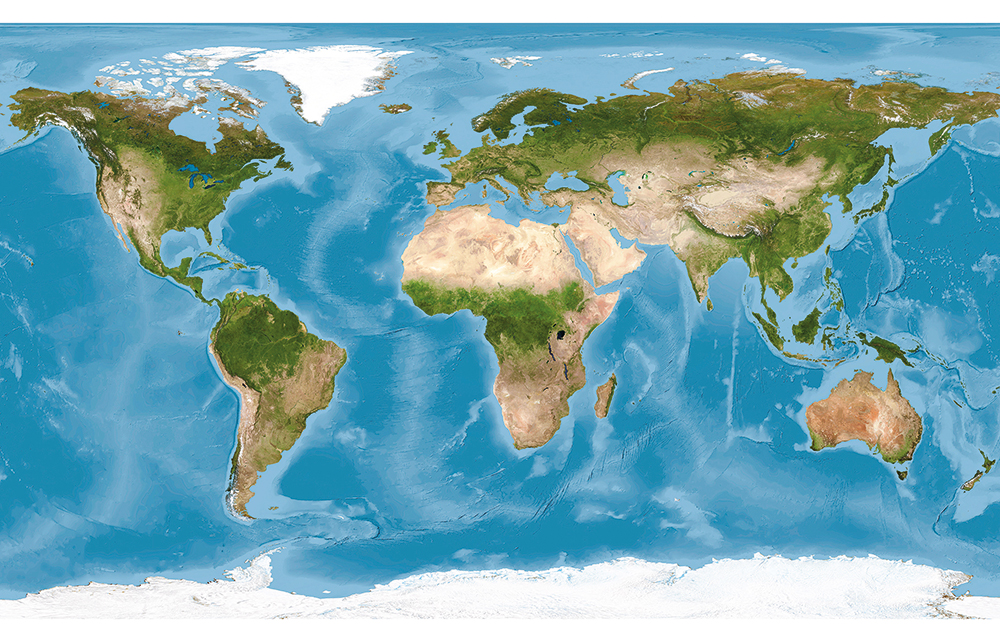When we observe the ocean we rarely peek beneath its surface. As Helen Czerski shows in her lively and engrossing account of the physics of ocean spaces, we would not see much anyway. Sounds travel well in water, and blue whales talk to one another across thousands of miles; but light soon disappears, apart from the glow emitted by luminous fish. Historians of the oceans (myself included) have looked at how, when and why people have crossed the surface of these spaces, uninhabitable except in the security of a boat or on islands, such as those in Polynesia with which Czerski begins her book. But we need to dive deeper.
Out in Hawaii, she points out, ‘the ocean is as much part of home as the land’, and it was only from space that we have been able to appreciate the vast extent of Earth’s blue oceanic covering – 70 per cent of the globe, with the Pacific encompassing almost an entire hemisphere. And although we divide the ocean into several different ones, it is ultimately (as the ancient Greeks insisted) one big connected Okeanos. For Czerski, getting to the moon was a lesser achievement than seeing the Earth from there, and that sight should make us think more deeply about our responsibilities towards the planet, which is likely to be humanity’s only home, even if bubbles of settlement are created on the moon or Mars.
The blue machine is in many ways resilient, but will suffer permanent damage from rising sea levels
The argument about human responsibility is an undercurrent running through Blue Machine, and it is handled very deftly. Unlike some recent literature on the oceans, such as Callum Roberts’s powerful Ocean of Life, Czerski’s account is not impregnated with constant alerts about the damage we are certainly doing to a vast space upon which we depend much more than we realise. What she sets out to do, and does extremely well, is to show that the oceans constitute a vast, world-embracing machine, and that they are not just a mass of salty water indiscriminately sloshing around. For her: ‘Ocean is the big beast in Earth’s planetary machinery.’ Again and again she calls it an ‘engine’, and shows how important it is in maintaining heat levels in the atmosphere, but also how the balance that has to be maintained is very delicate: ‘The ocean is Earth’s thermometer.’ Her warnings are therefore subtle, but all the stronger for that.
The contours of the world ocean are not set simply by land, to which in any case we have to add the continental shelves that extend far beyond the present-day shores of our continents. Czerski is an exceptionally able guide to the peculiarities of how large quantities of water flow. There are currents such as the Gulf Stream, that retain warmth as they travel past cooler parts of the ocean, in this case determining the mild climate of the British Isles. There is the Sargasso Sea in mid-Atlantic, feared by immobilised navigators in the days of sail, which she describes as ‘the only sea on Earth with no hard boundaries’. There is the Southern (or Antarctic) Ocean, whose southern edge is a frozen continent but whose northern edge is defined by the Antarctic Circumpolar Current that swirls around the globe. There are the gyres, ‘cogs’ in the great oceanic machine, that move water around the Pacific and the Atlantic, divided between northern and southern gyres, because these currents are unable to cross the Equator, with its distinctive climate.
Then, within the Indian Ocean, a very different system operates, so that the interplay between smooth currents and monsoon winds may have made it easy for the Ming emperor to send enormous flat-bottomed ships all the way from China to East Africa in around 1400, sliding along ‘nature’s conveyor belt’ – although Czerski admits that there is doubt about their size and suitability for the open ocean. Presumably, though, the same smooth route explains the extraordinary voyages of Malay speakers to Madagascar, which they were the first to colonise somewhere around the 6th century.
Alongside her vivid portrayal of waters sliding over one another, colliding, mixing and turning into ice or water vapour, she explains how the living beings within the sea also form part of the ‘blue machine’: from microscopic seafood ingested by plankton, themselves ingested by fish, all the way to the massive bluefin tuna and the greatest giant of all, the blue whale. Here human intervention has induced calamity. The killing of the great majority of blue whales led to a dramatic reduction in krill, an important part of the feeding cycle within the oceans. The krill lived off what Czerski insistently calls poo, in this case the iron-rich, red excreta of the blue whales.
Keeping everything in balance is one of the functions of the blue machine, but the burning of fossil fuels and the gradual raising of world temperatures poses a significant threat to how it works. It is only at the very end of her book that Czerski directly addresses the environmental changes that have been taking place. Her concern up to that point has been to set out clearly and calmly the design of the ocean engine. But by the time she reaches her short closing chapter on ‘the future’, it is clear what the arguments will be: that the blue machine is in many ways resilient, but will suffer permanent damage from rising temperatures. Melting ice will raise sea levels; currents will be diverted; the fishy inhabitants of the ocean will disperse and in some cases disappear; tropical storms will increase in frequency and power; sub-surface areas of the oceans will be de-oxygenated – all that alongside our abuse of the ocean as one big dumping ground for plastic and other detritus. The oceans absorb carbon (though tropical waters breathe out carbon dioxide), and determine global temperatures, but there are limits to their capacity for absorption of carbon unless we bring fossil fuels under control.
The question of how humans relate to the ocean is therefore of great importance. Czerski brings out the sense of detachment from the ocean that has followed technological developments since the 19th century. Steamships no longer depended on the natural forces of winds and currents; information was transmitted by cable and later radio; much more recently, there has been the invention of GPS. She depicts herself hanging from the rigging of the Cutty Sark, arguing that mechanisation has distanced us from the ‘raw reality’ of the oceans and from the awareness that we have to go along with nature rather than ignoring it.
The Polynesians possessed the ability to know the texture of the sea intimately – far better than Captain Cook and his contemporaries; but that knowledge has largely seeped away. For us, the oceans have become ‘absence’ rather than ‘presence’. We now fail to engage with them when we travel long distances, flying over them in aeroplanes rather than getting the feel of the waves – or even bothering to look out of the plane window at them. Meanwhile our great ports have become enormous automata, processing vast numbers of containers, with the prospect of even captains and crews working from home on land in Phoenix, Arizona or Chengdu.
Yet when it comes to the future, Czerski is not entirely pessimistic, expressing hope that international co-operation and a greater sense of what life on Earth owes to the oceans will at least attenuate the challenges we face as world temperatures creep upwards. This may be too much to hope for, but the news a couple of months ago that the United Nations has brokered an international treaty whose aim is to promote marine biodiversity could be an important step in the right direction.
Czerski is a skilled presenter on TV, and she likes to make her presence felt on the page as well. In many books of popular science the author’s intervention is an irritation, a chatty way of lightening what can be a forbidding presentation of, say, quantum mechanics. But here it works. As she says: ‘This is not the sterile science of the lab: it’s the real world.’ Her personal experience of both Polynesian canoes off Hawaii and ice floes near the North Pole is not icing on the cake but part of the argument of this excellent and important book.







Comments